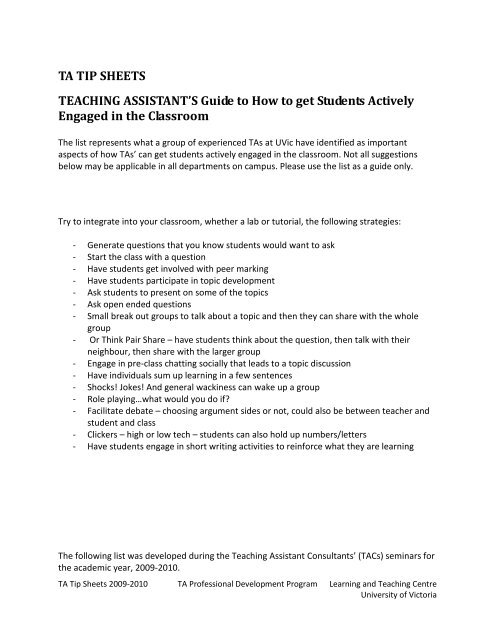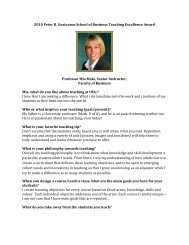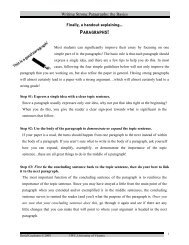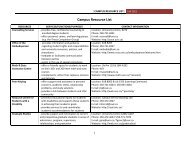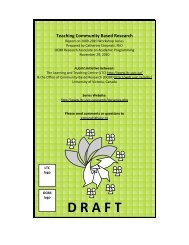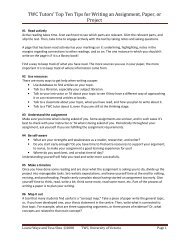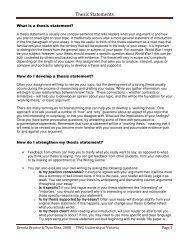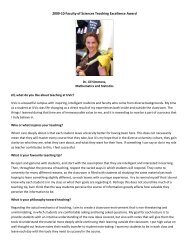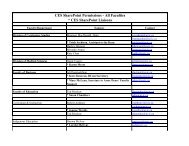Guide to How to Get Students Actively Engaged in the Classroom
Guide to How to Get Students Actively Engaged in the Classroom
Guide to How to Get Students Actively Engaged in the Classroom
Create successful ePaper yourself
Turn your PDF publications into a flip-book with our unique Google optimized e-Paper software.
TA TIP SHEETSTEACHING ASSISTANT’S <strong>Guide</strong> <strong>to</strong> <strong>How</strong> <strong>to</strong> get <strong>Students</strong> <strong>Actively</strong><strong>Engaged</strong> <strong>in</strong> <strong>the</strong> <strong>Classroom</strong>The list represents what a group of experienced TAs at UVic have identified as importantaspects of how TAs’ can get students actively engaged <strong>in</strong> <strong>the</strong> classroom. Not all suggestionsbelow may be applicable <strong>in</strong> all departments on campus. Please use <strong>the</strong> list as a guide only.Try <strong>to</strong> <strong>in</strong>tegrate <strong>in</strong><strong>to</strong> your classroom, whe<strong>the</strong>r a lab or tu<strong>to</strong>rial, <strong>the</strong> follow<strong>in</strong>g strategies:- Generate questions that you know students would want <strong>to</strong> ask- Start <strong>the</strong> class with a question- Have students get <strong>in</strong>volved with peer mark<strong>in</strong>g- Have students participate <strong>in</strong> <strong>to</strong>pic development- Ask students <strong>to</strong> present on some of <strong>the</strong> <strong>to</strong>pics- Ask open ended questions- Small break out groups <strong>to</strong> talk about a <strong>to</strong>pic and <strong>the</strong>n <strong>the</strong>y can share with <strong>the</strong> wholegroup- Or Th<strong>in</strong>k Pair Share – have students th<strong>in</strong>k about <strong>the</strong> question, <strong>the</strong>n talk with <strong>the</strong>irneighbour, <strong>the</strong>n share with <strong>the</strong> larger group- Engage <strong>in</strong> pre-class chatt<strong>in</strong>g socially that leads <strong>to</strong> a <strong>to</strong>pic discussion- Have <strong>in</strong>dividuals sum up learn<strong>in</strong>g <strong>in</strong> a few sentences- Shocks! Jokes! And general wack<strong>in</strong>ess can wake up a group- Role play<strong>in</strong>g…what would you do if?- Facilitate debate – choos<strong>in</strong>g argument sides or not, could also be between teacher andstudent and class- Clickers – high or low tech – students can also hold up numbers/letters- Have students engage <strong>in</strong> short writ<strong>in</strong>g activities <strong>to</strong> re<strong>in</strong>force what <strong>the</strong>y are learn<strong>in</strong>gThe follow<strong>in</strong>g list was developed dur<strong>in</strong>g <strong>the</strong> Teach<strong>in</strong>g Assistant Consultants’ (TACs) sem<strong>in</strong>ars for<strong>the</strong> academic year, 2009-2010.TA Tip Sheets 2009-2010 TA Professional Development Program Learn<strong>in</strong>g and Teach<strong>in</strong>g CentreUniversity of Vic<strong>to</strong>ria
TA Tip Sheets 2009-2010 TA Professional Development Program Learn<strong>in</strong>g and Teach<strong>in</strong>g CentreUniversity of Vic<strong>to</strong>ria


